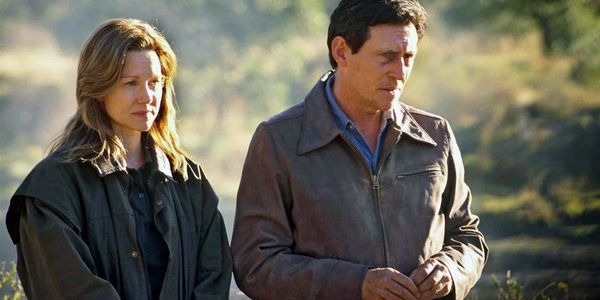Eye For Film >> Movies >> Jindabyne (2006) Film Review

New South Wales, the present day. A young Aboriginal woman is driving through a remote landscape. A man in a truck forces her to pull over, then rapes and murders her.
Meanwhile, four friends are preparing for a weekend’s fishing trip. Hiking to a remote but beautiful stretch of river their male bonding idyll is shattered when Stewart (Gabriel Byrne) discovers the girl’s body. Instead of immediately contacting the police, they continue fishing...

Australia: what are you bloody waiting for? Certainly, Jindabyne is unlikely to feature in any tourist board marketing campaigns. But as the eagerly-awaited follow-up to director Ray Lawrence’s critically-acclaimed Lantana it’s a compelling look at the tensions and contradictions behind the image of ‘The Lucky Country’.
Ironic, then, that the source of the screenplay is a short story (So Much Water So Close To Home) by American writer Raymond (Short Cuts) Carver, relocated in both time and setting. But it chimes well with several of the dominant themes in Lawrence’s earlier work – masculinity in crisis, the need to keep secrets hidden and the human capacity for both amoral indifference and altruistic kindness in the face of a harsh and tragic world.
Initially, the audience is appalled by the men’s apparently callous behaviour - and there’s a certain schadenfereude when, on their return, they finally contact the police and are pilloried and ostracised by the rest of the town, particularly the Aboriginal community, when word gets out.
But, as in Lantana, the male characters are not simply unfeeling boors. The scene in which they decide not to halt their trip is a masterpiece of the unsaid, where each character obviously realises the wrongness of their actions, but allows himself to be persuaded.
As the pressure to explain themselves properly (and apologise to the dead girl’s family) grows, the problems and secrets of their lives come to the surface and it is left to Stewart’s wife Claire (Laura Linney) to force them all to come to terms with what they have done.
The film is not an easy watch, in any sense. Emotions are raw, themes of domestic violence and misogyny loom large, and the audience has to do some of the work in fathoming the motives of four very different (but equally emotionally illiterate) men. And though the murderer is revealed early on to be a member of the community, there is no thriller-style hunt to unmask his identity or tension over when he will strike next. He is simply a permanent reminder of the community’s guilty secret, as much a product of his time and place as any of the characters.
This could all be simply gloomy and unsatisfying. But, like Lantana, the film steadily builds a rewarding and life-affirming power through the four men’s ability to overcome their demons, and rediscover what made them good fathers, husbands and people in the first place. Lawrence does not judge or editorialise, he merely observes and tries to understand.
Such a strategy stands or falls on the performances it inspires, of course. But Lawrence again proves himself to be a superb actors' director and his cast rises to the occasion. More than 20 years on from Defence Of The Realm, Byrne still exudes charisma, but he also brings a world of frustration and disappointment to his character, a former rally star now running a struggling garage. His set, weary features convey a world of lost hopes and his sudden rages are all the more shocking for the quiet that precedes them.
He is matched by Linney, showing once again her talent for portraying flawed but fundamentally decent people. Her dogged insistence on a reconciliation with the girl’s family is met with hostility from both sides of the community. And it would have been easy and glib to portray her actions as an American outsider’s misguided attempt to go all touchy-feely on the no-nonsense Aussies.
Instead, Lawrence makes it clear that going the extra mile is just what the situation needs and that the men’s silence is not straight-up Oz machismo but an unwillingness to acknowledge their guilt.
Mention should also be made of the film’s setting, which serves almost as an extra character. Jindabyne is a town relocated to make way for a dam, with its original houses now just under the surface of a huge lake, a source of ghoulish legends and a metaphor for the painful secrets of the characters’ buried pasts. The surrounding countryside is beautifully shot by cinematographer David Williamson: a landscape undeniably stunning, but also remote, silent and inexplicably sinister. Older legends about the river and the mountains being a trail for spirits to pass through are subtly referred to, and there is a hint that this influences the four men’s decision.
Again, this could have been crassly hammered home. But Lawrence prefers to suggest, and the film is much richer for it. Not all the many themes are satisfactorily explored and resolved, and the short final scene is confusing and unnecessary. But overall, this stands comparison with Lantana, and older classics such as Picnic At Hanging Rock, as an evocation both of the Australian landscape’s strange otherness, and its peoples’ common humanity.
Reviewed on: 11 Mar 2007




















